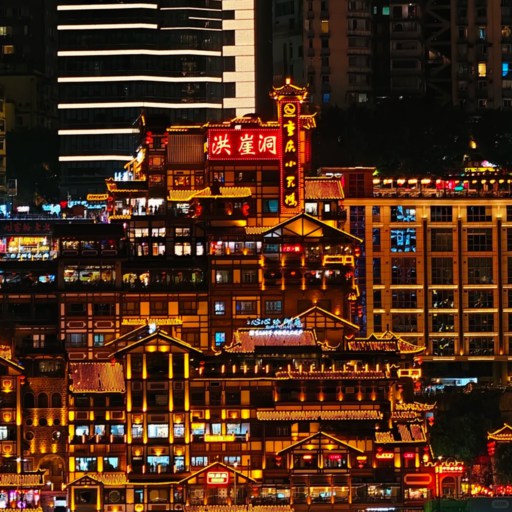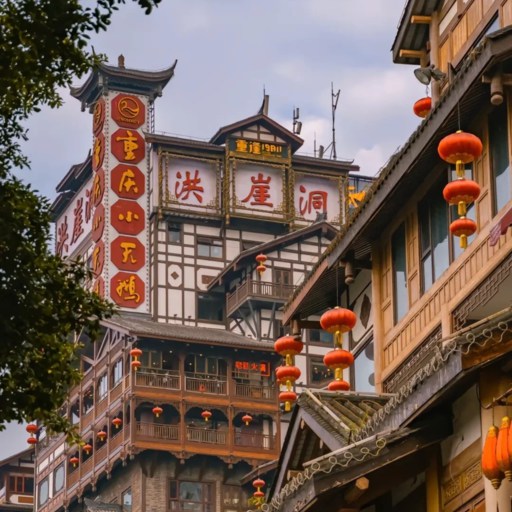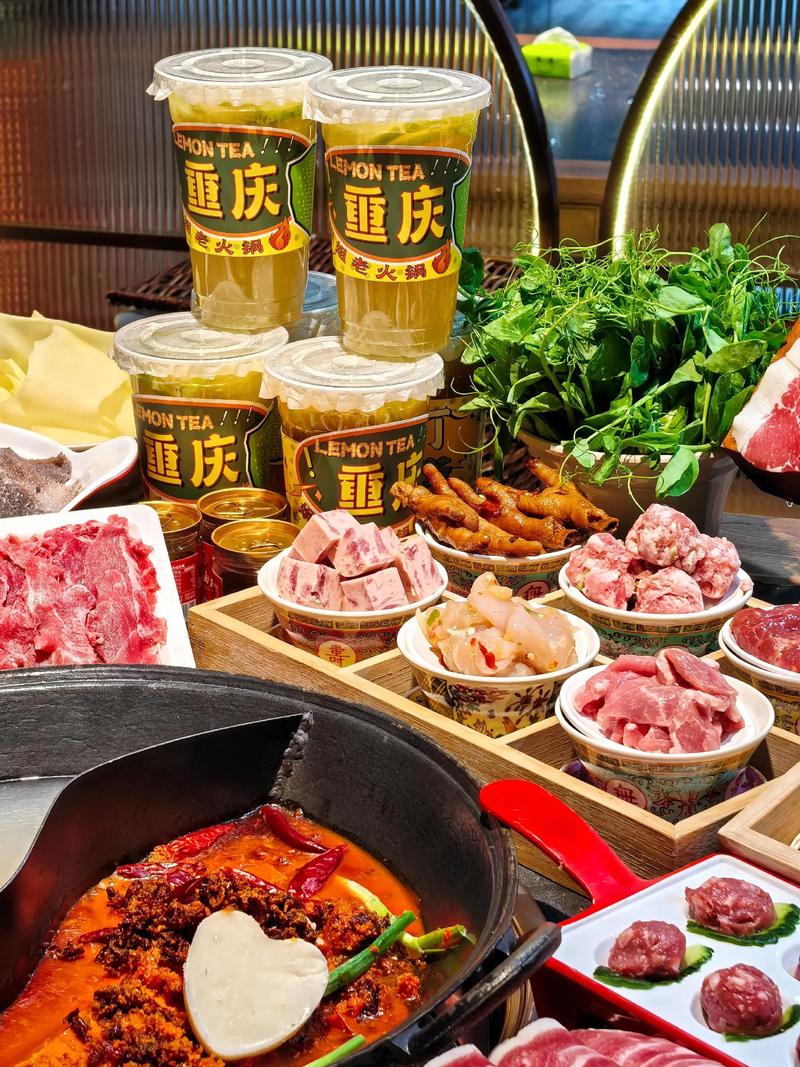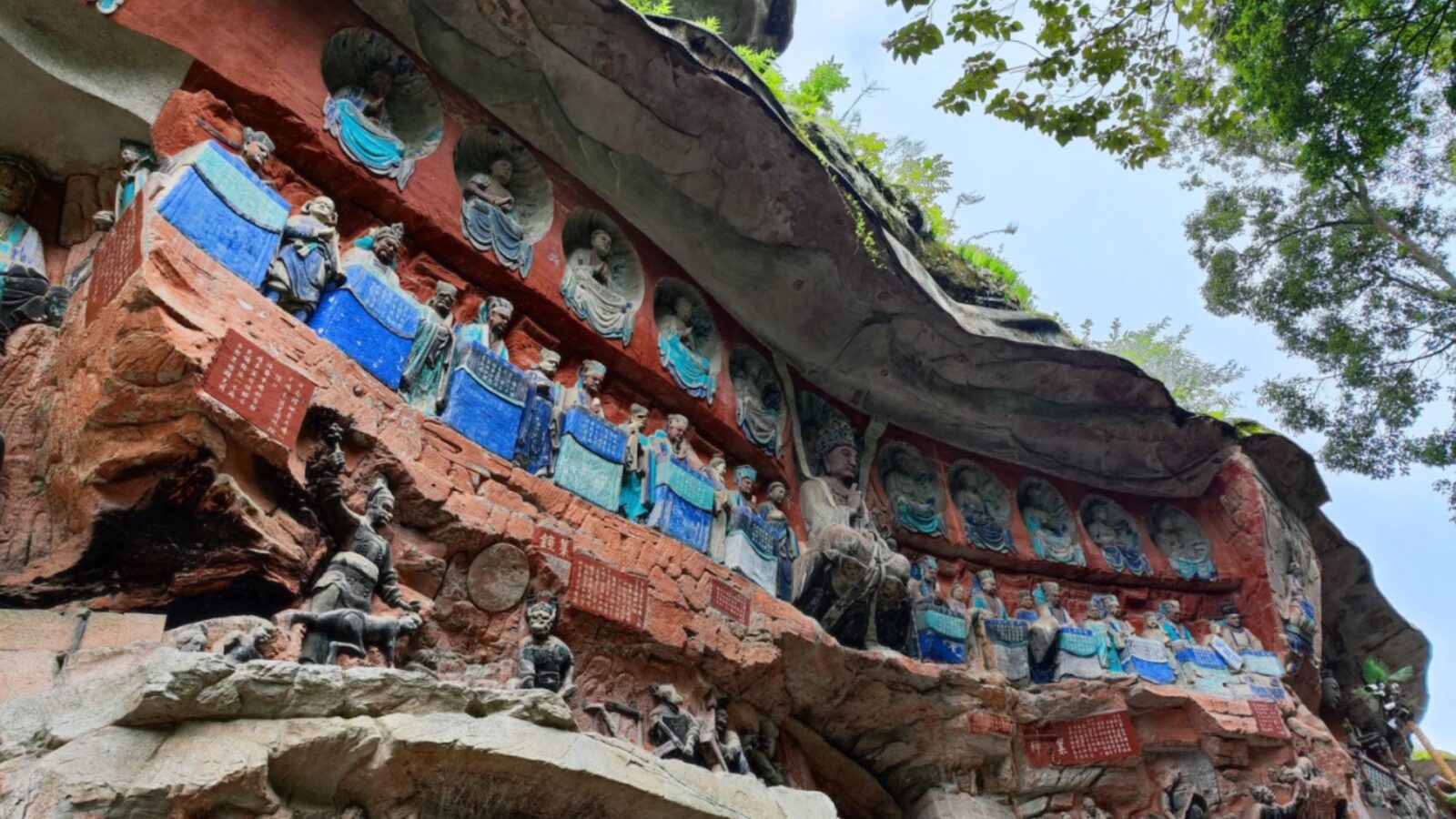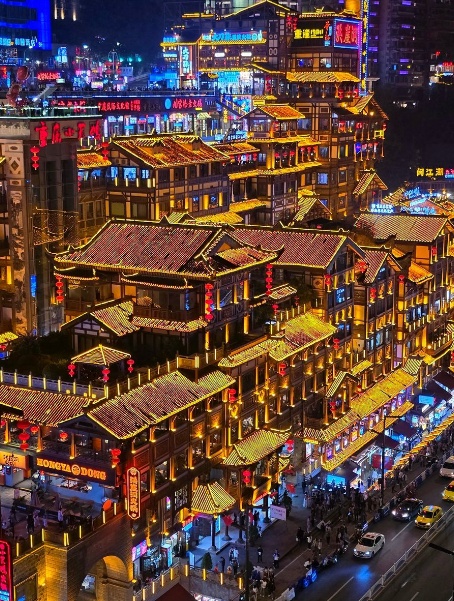
Hongya Cave
Hongya Cave didn’t appear out of nowhere with all that neon; it’s been part of Chongqing’s story for more than 2,000 years. When it served as a Ba Kingdom fortress, boats docked here to unload salt and silk, and watchtowers once stood on the same cliff where restaurants now glow. The stilt houses you see aren’t ancient, but they keep that old rhythm — wooden frames, smoky kitchens, and red lanterns drifting above the Jialing River. Locals come for late-night skewers and cheap beer, while tourists crowd the decks to catch the glow right after 7 p.m., when the cliff’s layers light up one by one. Hongya Cave feels alive, noisy, and a little chaotic — and honestly, that’s exactly what makes it unforgettable.
Quick Facts about Hongya Cave
| Location | Jialing River Bank, Yuzhong District, Chongqing |
| Opening Hours | 24 hours (open area), shops till 11 p.m. |
| Light-up Time | Around 7 p.m.–10:30 p.m. daily |
| Tickets | Free entrance |
| How to Get There | Metro Line 1 or 6 to Xiaoshizi Station |
| Famous for | Night view, food street, stilt buildings |
Why Hongya Cave Fascinates and Frustrates Travelers Alike

Light of Hongya Cave
The Allure — A Real-Life “Spirited Away” Moment in Chongqing
Popular press keeps calling Hongya Cave the real-life Spirited Away, and for once, the internet isn’t lying. The entire place clings to the cliff, as if afraid to slip into the Jialing River, yet it glows with impossible warmth. You walk through those long wooden halls, and the air smells of grilled squid, soy sauce, damp wood, and faint perfume drifting from the crowd.
I still remember the first moment the lights came on; the whole mountain seemed to pulse like a single living thing. That’s the Hongya Cave night view everyone online keeps raving about, and honestly, no phone camera can capture it. Locals sip beer on balconies, musicians strum cheap guitars, and when you glance across the river, the skyline feels like another planet quietly staring back.
The Crowds and Confusion — Why Some Travelers Complain on TripAdvisor
That magic does not last long when you arrive at an inopportune time. TripAdvisor reviews are harshly straight to the point: Too crowded but beautiful or Worth it, but only once. They’re not wrong. You will squeeze through souvenir stores with the same pop song being played, as well as kids waving at you with sticks that are glowing. The lifts rival, the posters are meaningless, one of them even reads No enter in rainy day and the aroma of hotpot somehow trails you eleven stories. It is Hongya Cave on Chinese disorder: beautiful and disheveled, cultural and commercial. It is difficult sometimes to determine whether you are visiting a heritage site or are just caught inside a mall, which is in actuality a heritage site. Nevertheless, that is the bargain of it, this city does not distinguish between reality and show.
How to Enjoy Hongya Cave Without Losing Your Mind
This is what the majority of guides fail to say. Get there early, around 5:30 p.m., grab something small to eat on the lower street, and stay put until the lights switch on. Avoid weekends if you can, and skip most of the shops — half of them sell the same chili keychains anyway. The smarter move is to climb two or three floors above the food street, where a small balcony faces the bridge. You can breathe there and actually watch the cliff light up slowly against the dusk.
When you read the Hongya Cave writing on the Chinese signs, you’ll notice each floor has its own poetic nickname — Yanyu (烟雨) for mist, Xiajiang (下江) for the river — quiet nods to old Chongqing verses. Do it right, and Hongya Cave stops being a tourist trap. It turns into a glowing, noisy cliff that somehow pulls the whole city together — dense, hungry, and alive.
Hongya Cave Highlights: What Awaits on Its 11 Floors
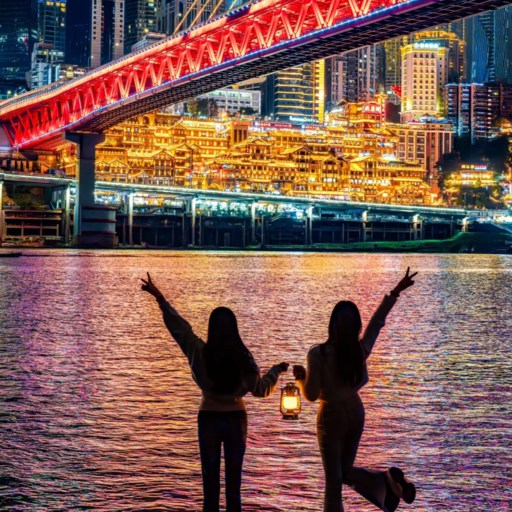
Photo Spots of Hongya Cave
From Riverside to Skyline — How Hongya Cave Is Built on a Cliff
You are not aware of how wild Hongya Cave is until you stand by the river and look up. It is all suspended on a cliff as though somebody had stuck a small city to the rock. The lower levels cut almost into the stone itself, while the upper decks stretch out over the Jialing River on a forest of wooden stilts. It’s not a trick; builders followed the ancient Bayu architectural style called diaojiaolou (吊脚楼), a stilt-house design that keeps homes dry when the river floods. The wooden beams look aged and smoke-darkened, yet glass elevators run straight through them, glowing faint blue even at night.
When you step from the riverside entrance to the top floor, it feels like walking out of old Chongqing and into its futuristic reflection. There’s even an official plaque that declares, “The structure represents the vertical spirit of the city,” and honestly, it does. The entire Hongya Cave stands upright like a living piece of Chongqing itself, rooted in stone yet reaching for light.
Every Level Tells a Story — Food Stalls, Souvenirs and Live Music
The Hongya Cave is like eleven worlds that are one at the same time. It is all food down the lower, the hot odor of skewers, the hotpot broth, the tofu fried and that stinky bite I will never forget. Venders shout at each other in an attempt to entice you to buy grilled squid or sugar-coated hawthorn at 10 RMB with them.
The woks and chili oil sizzle can be heard long before you even see the stalls. Climb further and you will have the souvenir shops: magnets, little lanterns, and even tiny keychains in the shape of the Hongya Cave building itself. Local bands perform at the small bars which open at night and they play Mandopop to folk songs. Certainly some of these are touristy, but every now and then, you happen upon a voice so gravelly that it cuts through the noise of the crowd. This was when you know, this is not a sterile attraction, this is where the people work, eat and breathe. The photos of the Hongya cave which are plastered online fail to show that mixture of sweat and chili smoke and laughter.
The Old vs. New — Stilt Houses Meet Neon Screens
Traditions and technology collide in the most Chongqing manner on the upper tiers. There are wooden lattice windows with LED signs blinking fire hokka and Souvenir Here. It is so absurd, yet it does. The old stilt houses lean slightly, and as people walk past, they creak underfoot. Beside them, digital billboards glow, flashing the newest bubble-tea adverts that color the walls in shifting tones. I stood by one of those windows while the light danced across the river, and for a moment, the reflections made the entire building look alive, almost breathing. The Hongya Cave within feels not only like architecture but rhythm itself, layered from the earth below to the sky above.
People say the stilted houses embody a way of living — climbing mountains to eat from the mountain, drawing water to drink from the water — living entirely on what the land provides. That’s exactly what this place does: it consumes the mountain, drinks the river, and shines because that’s what Chongqing does. When you finally reach the rooftop and watch the skyline sweep across the water, Hongya Cave no longer feels like a structure of wood, glass, and neon; it feels like a heartbeat pulsing in the city’s chest.
When and Where to See Hongya Cave at Its Best
- Night Scene of Hongya Cave
- Daytime Scene of Hongya Cave
Light-Up Time and Best Night View Spots Across the River
When you have seen those flushed postcard pictures of Hongya Cave night view, the following is the truth about it all, they are usually captured between 7 p.m. and 8 p.m. which is when the Hongya Cave lights are on. The timing matters. The cliff begins to waver at the bottom to the top, as though some one is painting a picture of the city slowly. As one of the users on TripAdvisor named Nomad_Lisa says, the moment the roof lights up, no one remembers that they were sweaty or tired. She is not wrong, that is when even locals stop in the Jialing River Bridge to take a gawk.
If you’re into tracing the deeper roots of Chongqing’s skyline and heritage, you might want to read this detailed guide to its most iconic landmarks — see the full list of Chongqing historical sites here.
The best place to capture it? Go to the other bank, off the river side platform adjacent to the Raffles City Mall. Then you can fit the entire 11-floor exterior inside your frame and the reflection is waving over the water. The other underestimated sight is that of the light-rail window of Line 6 just prior to Xiaoshizi Station - it is a matter of few seconds but the whole Hongya Cave looks like a lantern in motion.
Morning and Daytime - What most of the tourism miss
It is sad that a majority of the people do not visit Hongya Cave during the day. The wooden beams appear rough and exposed to sunlight rather than neon and golden in the morning, before 10 a.m. The smoke from hotpot hasn’t taken over yet, and you can actually hear birds calling under the bridge, mixed with the hum of delivery scooters heading to work. Vendors prepare their skewers calmly, unhurried, and if you linger long enough, they might hand you a free bite just because you showed up early.
If you’re curious about what else to explore when the sky turns grey or drizzles hit Chongqing’s riverside streets, you might want to check this local-style guide on how to spend a rainy day in the city.
I sat on the lowest deck, spending 18 RMB on a bowl of noodles as the first ray of light touched the river. The cliff looked gentle then, almost shy, its wooden beams glowing softly instead of blazing. This quiet version of Hongya Cave never makes it into glossy travel videos, yet it’s real — a slower, dimmer rhythm of a place usually too busy performing for its own fame.
Avoiding Crowds — Timing and Photo Tips Only Locals Know
The locals will inform you that it is not when one should go, but how to move. Take the Xiaoshizi Station Exit 1 at about 5.30 pm and ascend up through the back lanes rather than using the main gate and you would find yourself at the seventh floor - already above the commotion. Wait until the Hongyacave light up, and go down gradually when all the rest of the people are struggling to climb up.
None of them want 50 phones in a photo, they want a clean shot. Wait, wait till 10 p.m. half the crowd departs after dinner but the lights remain on till about 10.30. Carry a tripod when you are patient enough - sometimes security requests it to be folded up. My favourite place is a small terrace with the sign prohibiting passage (technically it means no entry, but all people disregard it). You can take shots there of the curve of the bridge, with the neon reflection folding over the Jialing. This is Hongya Cave at its finest, bit of breaking the rules, much of the radiance, and that kind of nauseating combination of noise and beauty that only Chongqing can snatch away.
What to Eat Near Hongya Cave
- Hotpot in Hongya Cave
- Street Snacks in Hongya Cave
Top Local Bites — Hotpot Steam, Spicy Noodles and Street Snacks
Enter Hongya Cave and the visual impression is pushed aside by the olfactory one. Thick air of chili oil, garlic and grilled meat smoke that clings to your clothes fills the air. The food scene here is wild — boiling hotpots bubbling over tables, beef kebabs bursting beside men yelling prices that drop the longer you stare. A bowl of suancai fish noodles from a stall near the fourth floor costs 25 RMB, and the broth hums with Sichuan peppercorn heat that numbs your lips in a strangely addictive way. You’ll also spot older women frying xiao mian (Chongqing spicy noodles) in woks darkened by years of smoke and fire.
Even the constant whine of the escalator can’t drown out the sharp soprano hiss of chili oil. The place feels loud, fragrant, and alive, a kind of beautiful disorder that mirrors the city itself. It’s messy and unpolished but impossible to forget — just like Chongqing, restless and burning, in every bite.
Hongya Cave Food Street vs. Real Chongqing Flavors Nearby
The following is the reality concerning the Hongya Cave food scene: the majority of people dine in the wrong level. The Food Street looks stunning in photos, with lanterns glowing and cooks tossing noodles high in the air, yet most locals avoid it. Prices rise the closer you get to the river view — imagine 40 RMB skewers that cost 15 RMB just two blocks away. TripAdvisor reviewers call it “pretty but expensive,” and they’re right about that. For something authentic, walk five minutes uphill toward Bayi Road, where the real charm begins.
There, a row of open-air stalls sells duck blood hotpot, grilled eggplant with garlic, and spicy sticky rice balls that no one regrets. The smallest stall, Lao Ma Tan Huo, has no English menu, just a greasy laminated sheet, yet they smile when you point at a photo. In the shadow of the main complex, the true Hongya Cave food energy stays alive — smoky, loud, and real — where the smells cling to your jacket and locals actually eat.
FAQ About Hongya Cave
Q: What time does the Hongya Cave light up?
The Hongya Caves lights are normally turned on around the time of 7:00 pm, however this light up time of the Hongya Caves may vary slightly depending on the season or weather. Majority of the visitors indicate that the best time to see the entire glory is 7:15 -7:30 p.m. You will get good photos, but you have to do it earlier and have to set up across the Jialing River before the crowd cuts across your picture. The lights remain lit until about 10.30 p. m. when they dim floor by floor.
Q: What is the age of Hongya Cave and its history?
Its original location is more than 2.300 years old, having been a fortress on the banks of the river in ancient Ba Kingdom. In 2006, the complex of Hongya Caves was reconstructed according to the diaojiaolou (stilt-house) design. So even with the new wood and glass, the soul of old Hongya fortress exists. You will find plaques in both Chinese and English (occasionally misspelled) telling of this strata past.
Q: Which is the most good location to view Hongya Cave night?
Raffles City Chongqing The opposite bank is sworn by locals and photographers. It is the ideal distance of having a full shot without the lens distortion. The other nice viewpoint is at Line 6 of the light rail sit right outside the right window prior to entering Xiaoshizi Station and then you will have five seconds of the pure neon magic. Bring a tripod in case you are serious but bear in mind that the Hongya Cave night view is better than anything you see on a phone screen.
Q: Are you able to sleep in Hongya Cave hotel buildings?
There are some boutique hostels and inns hidden within the complex, albeit on the higher floors. They are easy to access and noisy - live music and chatter on the streets continue after midnight. Ctrip reviews refer to them as fun but sleepless. In case you are more comfortable, there are other similar businesses within a few minutes distance such as Holiday Inn Express Chongqing Jiefangbei or Somerset Raffles City, they are less noisy, both accept foreign guests, but still have a view of Hongya Cave.
Q: Is Hongya Cave safe to visit at night?
Absolutely. It is a popular tourist area in Chongqing, which is patrolled. The greatest danger is that one hits anyone or trips on those steep stairs. Watch your bag, and do not go too deep after 10.30 p.m., when the stores are closed and no lights on. Otherwise, nighttime in Hongya Cave is not so dangerous.
Q: What food should I try in Hongya Cave?
Begin with the Chongqing hotpot and proceed to the street skewers, suancai fish noodles and grilled tofu. The Hongya Cave food street provides fast food, yet locals believe that the best tastes are located outside the complex, small family restaurants behind the Bayi Road or under the Qiansimen Bridge. In case the odor of chili oil remains on your jacket then you have likely eaten well.
Q: How to reach Hongya Cave from Chongqing Jiefangbei or metro station?
It is a 10-15 minutes down down the hill of Jiefangbei Pedestrian Street. Take signs at both English and Hongya Cave in Chinese (洪崖洞). Take Line 1 or 6 by metro to Xiaoshizi Station, Exit 1. There is a brief ride on an escalator that gets you at the entrance itself. Cabs are also okay- only have to tell the driver Hong Ya Dong.
Q: How long do I need to visit Hongya Cave?
Two hours are sufficient to sightsee nonchalantly - one hour to eat and explore, the other to visit the Hongya Cave lights and photographs. Photographers usually remain three to four hours awaiting the glowing and reflections. When you are planning a combination of dinner and night view, aim to be there 5.30-9.00 pm. That is when all the crowds and all the smells and all the sky line all come together in a perfect combination of chaos.
